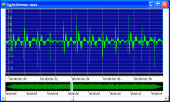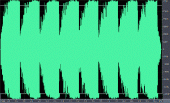Household Appliances and Electrical Equipment
The files in this section are recordings of RF noise from known household appliances and electrical equipment. If you can match noise at your location to one of these files then you can be confident that you know where your noise is coming from. Now all you have to do is find it and fix it!
RFI Noise
-
Contributor: Ralph, VE3BBM, via Jacques d'Avignon, VE3VIA
Noise Source: Light dimmer
Where Found: 152 kHz USB, but covers the LW and MW bands
-
Contributor: Ken, VE3HLS
Noise Source: My landlord's Sony TV set.
Where Found: 153 kHz USB, and several locations across the LW band.
Notes: Everyone knows TV sets make noise. But this was wasn't even on when the recording was made! I unplugged the set, then plugged it back in after a few seconds and the noise went away. However, it returned after the TV was turned on and then back off again.
-
Contributor: Ralph, VE3BBM, via Jacques d'Avignon, VE3VIA
Noise Source: Neighbor's exercise treadmill
Where Found:
Notes: It must have taken some interesting detective work to figure this one out! Nice work! (I think he had a narrow IF filter in at the time of the recording)
-
Contributor: Jacques, VE3VIA
Noise Source: Power Line Controls (PLC)
Where Found: Longwave band, various locations depending on the system in use.
Notes: PLCs are used for industrial control, and in commercial applications for applications like control of HVAC systems. They're finding increased use in homes and apartment buildings and condos as well. The X-10 control system is a basic PLC system that has been around for many years. PLCs use existing powerlines to send control signals, sort of a precursor to Broadband Over Powerline (BPL) that threatens reception on the HF bands. -
Contributor: N4EKV
Noise Source: A Sharper Image Ionic Breeze Quadra (electrostatic?) air cleaner
Where Found: Unknown
Notes: N4EKV reports the noise from the unit is so strong that it can be received more than 100 ft away from the house! Beware, if you hear this noise your neighbour may have one! -
Contributor: Alessandro, IT9HYR
Noise Source: Now Identified!
Where Found: Throught the 20 metre band.
Notes: Noise comes mainly from one direction (north) and lasts only 2 or 3 hours, then stops. No powerlines to the north, only a condominium and some cellphone towers. Note from the waveform that this is 50 Hz noise, i.e., 5 repeats of the noise in the 1/10 second window, not 60 Hz as used in North America. --- Ken, VE3HLSNote: Alessandro reported recently that he has identified the noise!
Dear Ken,
I find the noise source! It is a television set about 50 mt from my antenna in the north direction in the last floor of a condominium near my house. It is a Shaub Lorenz 20" stereo TV set made in Turkey. I belive that was a power supply mistake, but probably the noise came from the tube screen. At moment I cannot eliminate the noise, probably I will change (my charge) the TV with a new one HI HI.
Alex IT9YHR
 The image to the right was recorded on 20-meter AM.
The image to the right was recorded on 20-meter AM.The image to the right was recorded on 20-meter SSB.
-
General Instruments DSR-920 4DTV (satellite) receiver
Contributor: Web, KR4WM
Noise Source: General Instruments DSR-920 4DTV (satellite) receiver
Where Found: 6 metre band
Notes: Web says "This one was particularly annoying to me. It was worst on 50.125.189, close enough to interfere with the 6M SSB calling frequency! I could hear it in my mobile nearly a mile away, and on my FT-847 in my shack, it was a perpetual bother! One day, on a fluke, I was working on my home TVRO (satellite) dish, and unplugged my General Instruments DSR-920 4DTV receiver, and had my FT-847 monitoring 6M, and noticed the noise went away when I unplugged the DSR-920! A few times of plugging it back in and unplugging it confirmed my problem -WAS- the 4DTV unit! So now I live with it, knowing that I am my own source of interference! At least the signal strength is S-0..."Your website also helped me locate another source of interference, my two Ionic Breeze units! THANKS! -Web
-
No-name Brand Electric Blanket
Contributor: Bill, K2WH
Noise Source: No-name brand electric blanket
Where Found: Recorded on the 17 metre band, but found elsewhere.
Notes: Bill says "The noise is from a no-name electric blanket that was emitting this signal. I live on a lake and I was receiving it about S7 on peaks. I located the source on the other side of the lake ~ 400 feet in a neighbors house. While not terrible interference, I was curious to find the cause and silence it. The recording was made on 17 meters with an 80 meter dipole and tuner. The interference extended up to 6 meters but curiously not below 20 meters and with a squelched mobile receiver at 30mhz, would break the squelch just driving by. -
Fox Repel-tron Electronic Insect Repeller
Contributor: Mike, K7ING
Noise Source: Fox Repel-tron electronic insect repeller
Where Found: 1 to 15 MHz
Notes: "I have found the source of the RF noise. It's from a contraption called a FOX Repel-tron." -
Charger for Sony Digital 8 Video Camera
Contributor: Eric Behr
Noise Source: Charger for Sony Digital 8 Video Camera
Where Found: 160m Band
Notes: "This one had everyone stumped for a while. Narrow signal, about 1.5 kHz, audible only on sideband around 1845 and a few other close-by frequencies. It turned out to be a Sony charger for a Digital 8 video camera. The frequency on which the signals were heard seemed to drift very slowly up as the battery was charging. MP3 file attached. Thanks for the useful collection!"
-
Charger for Motorola Cordless Phone
Contributor: Bryan, W1BRI
Noise Source: Charger for Motorola cordless phone
Where Found: 140 to 170 MHz
Notes: "The battery charger is the cause of interference in the high VHF radio spectrum, 140 to 170MHz, and is caused only when the cordless telephone handset is placed in the charging cradle. The interference appears as a rapid swept frequency, six megahertz in width, anywhere within the VHF high band spectrum. The battery charger is the cause of several sources of interference on two meter amateur radio repeaters.The interference is best described as a buzzing sound with an approximate one second duty cycle. The interference has been heard in several locations, two of which are the source of the interference heard on the repeater input located 2500 feet from the source at an RF level of -80dBm. Directly in front of residence that contains one of these chargers the RF level measured -40dBm."
-
Contributor: Kevin, N6RCE
Noise Source: Switching Power Supply
Where Found: 1 to 14 MHz
Notes: "Here is a recording of a yet unidentified source of QRN. It's clearly a switching power supply. It put out a carrier every 200kHz, pretty accurately. It's about 8KHz wide. I've heard it from 1Mhz all the way up thru the 20M band, every 200kHz. Every other harmonic is stronger, as expected. The MP3 file was recorded with an ICOM R-20 in AM mode, with the filter width set to 15KHz. In this case, the frequency was 3200 kHz. The antenna was a simple shielded, tuned 80M loop made out of RG-58 coax." -
Contributor: Kelly, N6KJ
Noise Source: Battery Charger
Where Found: 40m to 6m, loudest on 40 and 20.
Notes: "The noise I heard lasts for about 1 second and repeats every 24 seconds. I heard it 24/7 on every band from 40M through 6M. I didn't check anything higher than 6M and my QRN level on 80M was too high to hear it. I heard it loudest on 40M and 20M." -
Here are two recordings submitted by Tom Tompson, W0IVJ. Tom is 99% sure this is grow light RFI. He futher stated that the source is about 3 blocks away from his home QTH. The recordings are made with a 6.6 kHz bandwidth on AM at a signal strength of -73 dBm and a 2.4 kHz bandwidth on LSB at a signal strength of -78 dBm.
Grow Light 6.6 kHz AM
Grow Light 2.4 kHz LSB
ARRL Lab Staff Contributions
The ARRL Lab discovered that an electric blanket emits RF noise. The blanket has two sets of controls for two separate heating circuits. They found that the blanket makes noise even when it's shut off and different characteristic noises when one side is on and the other is off, when they're both off, or both on. The following ten recordings cover all the possibilities, plus the recordings were made in AM and USB.
Contributor: Mike Gruber, W1MG and Ed Hare, W1RFI - ARRL Lab
Noise Source: Perfect Fit Low Voltage Fleece Warming Blanket, Queen Model #LVBQ-SB-1, made by Perfect Fit Industries
Where Found: Recorded on 28,350 kHz, with a 2.4 kHz IF filter on USB and a 10 kHz filter in AM.
-
Notes: One half of the electric blanket is turned OFF and the other half is OFF and unplugged. Recorded in USB and AM modes. The waveform of the AM recording is shown.
-
Notes: One half of the electric blanket is turned ON and the other half is OFF and unplugged. Recorded in USB and AM modes. The waveform of the AM recording is shown.
-
Notes: Both halves of the electric blanket are turned OFF and are plugged in. Recorded in USB and AM modes. The waveform of the AM recording is shown. Note that this waveform is 2.5 seconds in length, where are others are 0.1 seconds long. This is to better show the train of pulses emitted by the blanket. It would not show up on a 0.1 second view.
-
Notes: Both halves of the electric blanket are turned On and plugged in. Recorded in USB and AM modes. The waveform of the AM recording is shown.
Technology >> Radio Frequency Interference (RFI) >> Sounds of RFI >> Household




























